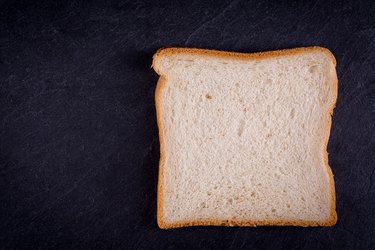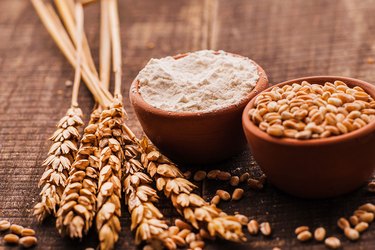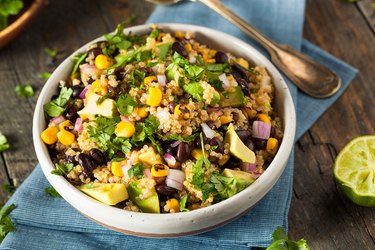In the last few decades, bread has really gotten a bad rap. But what's wrong with a little bread?
Well, for people with celiac disease, wheat, barley and rye are off limits. When gluten (the protein found in wheat, barley and rye) is ingested, it sets off an immune response that attacks the small intestine and impairs nutrient absorption. According to the Celiac Disease Foundation, it's estimated that 1 in 100 people worldwide is affected by this autoimmune disease.
Video of the Day
Video of the Day
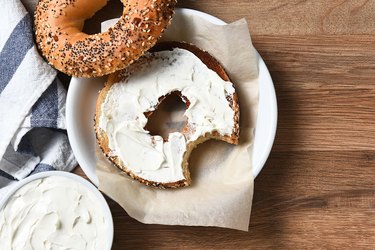
For everyone else, a little bread isn't harmful. But commercially made bread has very few nutritional benefits and many brands contain added sugars, artificial colorings, flavorings and preservatives.
What’s Wrong With Eating Bread?
There are three major concerns about eating a diet high in bread and wheat products: glycemic load, daily carb intake and the inflammatory effects of wheat.
Glycemic Index
The glycemic index measures (and ranks) how a food that contains carbs affects your blood glucose levels. Foods that rank above 70 are considered high glycemic because they spike blood sugar and insulin levels. In large amounts, these foods can contribute to weight gain and Type 2 diabetes.
The glycemic index of most store-bought breads — both white and whole wheat — is 70 or above, making them a bad choice if you're trying to manage your blood sugar levels.
Processed Carbohydrates and Daily Carb Intake
To maintain a healthy weight, it's important to watch your daily carb intake and be aware of the overall percentage of carbohydrates you are consuming.
Everyone has a different ideal percentage of macronutrients (carbs, fats and protein) in their ideal diet according to their lifestyle and biochemistry.
For example, some people may need a diet that contains about 50 percent of calories from carbohydrates. Ideally, most of those carbohydrates should come in the form of whole foods like vegetables, some fruit, legumes and whole grains.
If you're using most of those calories on eating processed foods like bread, you're leaving very little room for the occasional splurges that come with a balanced life (think: a glass of wine or chocolate).
Inflammatory Effects of Wheat
Chronic inflammation in our bodies has been linked to an increase in sugar intake and to a high consumption of cereal grains, namely wheat.
Inflammation can feed diseases like cancers and heart disease, so cutting back on inflammatory foods can help prevent these types of conditions.
If you're looking to lose weight and decrease inflammation, cutting back on bread and wheat products is a smart strategy.
10 Ways to NOT Eat Bread:
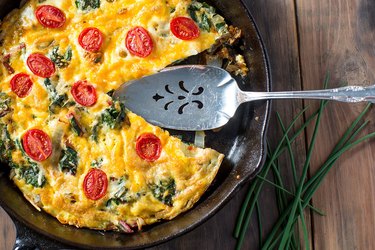
At Breakfast ...
1. Instead of cereal, bagels, waffles or pancakes, swapping in protein-filled eggs is a great way to start your day and keep your blood sugar levels steady. If you're used to eating eggs with toast, try substituting with a half of a baked sweet potato or a side of steamed broccoli.
2. Greek yogurt is another protein-packed breakfast idea that's quick, easy and bread-free. One cup of Greek yogurt contains approximately 15 grams of protein, which will help you feel satiated for hours afterward.
3. Can't live without your morning pancakes? Try whipping up an easy batch of flourless pancakes that contain just banana and eggs.
At Lunch ...
4. Turn your sandwiches into a salad: Take your favorite savory sandwich, ditch the bread and put it on bed of greens instead.
Egg salad, tuna salad, turkey and cheese, grilled veggies and pretty much any sandwich combo goes well on salad greens, which will save you about 22 grams of carbohydrates.
Prefer peanut butter and jelly sandwiches? Slice an apple and add peanut butter. The sweetness of the apple replaces the jelly and you get a hit of fiber as well.
5. Burritos are usually wrapped in flour tortillas that pack between 200-300 calories and up to 46 grams of carbs. Order a burrito bowl instead, with brown rice and beans to lower the glycemic load.
6. Many commercially made wraps contain low-quality oils and sometimes hydrogenated oils (aka, the dreaded trans fat) and they also come with a high calorie count. They also contain artificial flavors and preservatives, so swap the sandwich wrap for a collard green leaf instead and get a big dose of vitamins K, A, C and calcium.
At Dinner ...
7. Appetizers can be tricky, especially when it's a delicious cheese plate with a baguette or crackers. What you can request instead (or serve if you're hosting!), are cucumber "chips" and apple slices instead of crackers and bread.
8. Heading out for a burger? Order your burger wrapped in lettuce or served on a bed of greens, killing two birds with one stone. You increase the leafy greens on your plate and cut out the average 25 grams of carbohydrates from the bun.
9. Quinoa bowls are a great swap for bowls of pasta (pasta isn't a "bread," but it is made with wheat). Grain bowls topped with roasted veggies and a protein (beans, eggs, chicken, fish or beef), are a balanced meal in a bowl, without the wheat. Quinoa also contains eight grams of protein per cup when cooked.
10. Cauliflower crust is an excellent swap for any type of pizza or flatbread. Cauliflower has a very low GI and only contains 25 calories per cup.
What Do YOU Think?
Do you have any other tips or tricks to cut bread out of your diet? Do you eat bread? Why or why not? Do you notice a difference in your body when you stop eating bread? Leave a comment below and let us know!

